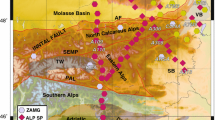Abstract
Receiver function analysis is applied to the western part of the Pannonian Basin, a rather complex region both geologically and geodynamically. Previous receiver function analyses in this region had to deal with much smaller station density and time span than those available to us. In the analysis we used the data of some 48 seismological stations. These include not only the permanent stations from Hungary and permanent stations from neighbouring countries (Slovakia and Slovenia), but also the temporary broadband stations that were installed within the framework of the AlpArray project. Having applied rather strict manual quality control on the calculated radial receiver functions we stacked the receiver functions. Using the H–K grid search method we determined the Moho depth and the Vp/Vs ratio beneath the seismological stations in the western part of the Pannonian Basin. The unprecedented density of the AlpArray network, combined with the permanent stations, allowed us to derive high resolution Moho and Vp/Vs maps for the West Pannonian Basin, together with uncertainty estimates. Our preliminary results agree well with previous studies and complement them with finer details on the Moho topography and crustal thickness.











Similar content being viewed by others
References
Ammon CJ (1991) The isolation of receiver effects from teleseismic P waveforms. Bull Seismol Soc Am 81:2504–2510
Ammon CJ (1997) An overview of receiver function analysis. http://eqseis.geosc.psu.edu/~cammon/HTML/RftnDocs/rftn01.html Accessed 22 Apr 2017
Crotwell HP, Owens JT (2005) Automated receiver function processing. Bull Seismol Soc Am 76:702–709
Fodor LI (2010) Mezozoos-kainozoos feszültségmezők és törésrendszerek a Pannon-medence ÉNy-i részén—módszertan és szerkezeti elemzés. DSc thesis, Budapest
Goldstein PD, Dodge M, Firpo LM (2003) SAC2000: signal processing and analysis tools for seismologists and engineer. IASPEI Int Handb Earthq Eng Seismol 81:1613–1620
Gráczer Z, Wéber Z (2012) One-dimensional P-wave velocity model for the territory of Hungary from local earthquake data. Acta Geodaetica et Geophysica Hungarica 473:344–357
Gráczer Z, Bondár I, Czanik C, Czifra T, Győri E, Kiszely M, Mónus P, Süle B, Szanyi G, Tóth L, Varga P, Wesztergom V, Wéber Z (2004–2015) Hungarian National Seismological Bulletin. http://www.seismology.hu/index.php/en/seismicity/earthquake-bulletins. Accessed 08 May 2017
Gráczer Z, Szanyi G, Bondár I, Czanik C, Czifra T, Győri E, Hetényi G, Kovács I, Molinari I, Süle B, Szűcs E, Wesztergom V, Wéber Z, AlpArray Working Group (2018) AlpArray in Hungary: temporary and permanent seismological networks in the transition zone between the Eastern Alps and the Pannonian basin. Acta Geodaetica et Geophysica Hungarica. https://doi.org/10.1007/s40328-018-0213-4
Grad M, Tiira T (2012) Moho depth of the European Plate from teleseismic receiver functions. J Seismol 16:95–105
Grad M, Tiira T, ESC Moho Working Group (2009) The Moho depth of the European plate. Geophys J Int 176:279–292
Helffrich G, Wookey J, Bastow I (2013) The seismic analysis code: a primer and user’s guide. Cambridge University Press, Cambridge
Herrmann RB (2013) Computer programs in seismology: an evolving tool for instruction and research. Seismol Res Lett 84:1081–1088. https://doi.org/10.1785/0220110096
Hetényi G, Bus Z (2007) Shear wave velocity and crustal thickness in the Pannonian Basin from receiver function inversions at four permanent stations in Hungary. J Seismol 11:405–414
Hetényi G, Ren Y, Dando B, Stuart GW, Hegedűs E, Kovács AC, Houseman GA (2015) Crustal structure of the Pannonian Basin: the Alcapa and Tisza terrains and the mid-Hungarian zone. Tectonophysics 646:106–116
Hetényi G, Molinari I, Clinton J, Bokelmann G, Bondár I, Crawford WC, Dessa JX, Doubre C, Friederich W, Fuchs F, Giardini D, Gráczer Z, Handy MR, Herak M, Jia Y, Kissling E, Kopp H, Korn M, Margheriti L, Meier T, Mucciarelli M, Paul A, Pesaresi D, Piromallo C, Plenefisch T, Plomerová J, Ritter J, Rümpker G, Sipka V, Spallarossa D, Thomas C, Tilmann F, Wassermann J, Weber M, Wéber Z, Wesztergom V, Zivcic M, Team ASN, Crew AOC, Group AW (2018) The AlpArray seismic network—a large-scale European experiment to image the Alpine orogeny. Surv Geophys. https://doi.org/10.1007/s10712-018-9472-4
Horváth F (1993) Towards a mechanical model for the formation of the Pannonian Basin. Tectonophysics 226:333–357
Horváth F, Bada G, Windhoffer G, Csontos L, Dombrádi E, Dövényi P, Fodor L, Grenercy G, Síkhegyi F, Szafián P, Székely B, Tímár G, Tóth L, Tóth T (2006) A Pannon-medence jelenkori geodinamikájának atlasza: Euro-konform térképsorozat és magyarázó. Magyar Geofizika 47:133–137
Horváth F, Musitz B, Balázs A, Végh A, Uhrin A, Nádor A, Koroknai B, Pap N, Tóth T, Wórum G (2015) Evolution of the Pannonian basin and its geothermal resources. Geothermics 53:328–352
Kennett BLN, Engdahl ER, Buland R (1995) Constraints on seismic velocities in the Earth from traveltimes. Geophys J Int 122:108–124
Lenkey L (1999) Geothermics of the Pannonian basin and its bearing on the tectonics of basin evolution. PhD thesis, Vrije Universiteit Amsterdam
Ligorría JP, Ammon CJ (1999) Iterative deconvolution and receiver-function estimation. Bull Seismol Soc Am 89:1395–1400
Ren Y, Grecu B, Stuart G, Houseman G, Hegedüs E, South Carpathian Project Working Group (2013) Crustal structures of the Carpathian–Pannonian region from ambient noise tomography. Geophys J Int 195:1351–11369. https://doi.org/10.1093/gji/ggt316
Schmid SM, Bernoulli D, Fügenschuh B, Matenco LC, Schefer S, Schuster R, Tischler M, Ustaszewski K (2008) The Alpine-Carpathian-Dinaridic orogenic system: correlation and evolution of tectonic units. Swiss J Geosci 101:139–183
Wessel P, Smith WHF (1998) New, improved version of the Generic Mapping Tools Released. EOS Transcr Am Geophys Union 79:579
Acknowledgements
The reported investigation was supported by the National Research, Development and Innovation Fund (No. K124241). Waveforms were used from the AlpArray temporary network (https://doi.org/10.12686/alparray/z3_2015), from the Hungarian National Seismological Network (https://doi.org/10.14470/uh028726), the Slovak National Seismological Network (https://doi.org/10.14470/fx099882) as well as the Slovenian National Seismological Network (https://doi.org/10.7914/sn/sl). We would like to thank to the authors of Generic Mapping Tools (GMT) software (Wessel and Smith 1998). The authors thank the two anonymous reviewers whose comments helped to improve the paper.
Author information
Authors and Affiliations
Consortia
Corresponding author
Rights and permissions
About this article
Cite this article
Kalmár, D., Süle, B., Bondár, I. et al. Preliminary Moho depth determination from receiver function analysis using AlpArray stations in Hungary. Acta Geod Geophys 53, 309–321 (2018). https://doi.org/10.1007/s40328-018-0218-z
Received:
Accepted:
Published:
Issue Date:
DOI: https://doi.org/10.1007/s40328-018-0218-z




